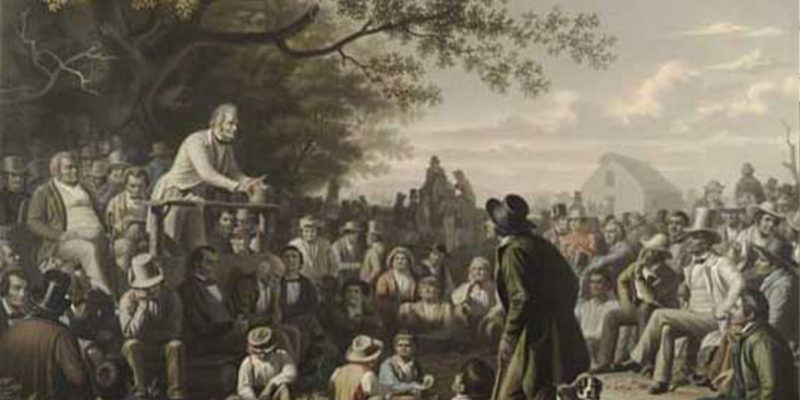Three great Western films—Stagecoach, The Man Who Shot Liberty Valance, and the contemporary No Country for Old Men—delve deep into the American psyche and make a broad claim that the American way of mixing freedom and rule is inherently flawed.
In a broad sense, classic Western films are often thought of today as lighthearted caricatures of a wild land that once was. This vision might accurately reflect a few films of the style but is by no means an accurate evaluation of many of the genre’s higher quality works, such as the classics Stagecoach and The Man Who Shot Liberty Valance and the contemporary No Country for Old Men. These films provide Western movies with the alternative reputation of being insightful portraits of American political psychology. The three films above delve deep into the American psyche and make a broad claim that the American way of mixing freedom and rule is inherently flawed.
The fundamental problem suggested by these films is that well-enforced law and pure, independent freedom are both wanted and, to varying degrees, needed in the American West but are unable to exist and function properly together in one society. Each of the films expresses this idea in its own way: Stagecoach by exploring how legal rules fail to solve complex issues; Liberty Valance by demonstrating how diverse human passions inhibit the formation of a singular political identity; and No Country by hypothesizing that even when law is seemingly well established, humanity wreaks havoc upon any order it might inspire. Despite each of these films’ unique way of addressing the issue of the opposition between law and freedom, their conclusions are similarly bleak: it may not be possible, at least in the United States, to resolve order and independence in a way every individual finds satisfactory.
The conflict that exists between law and freedom in Western films lends itself to the idea that both concepts are individually far more complex than meets the eye. Political thinker Thomas Hobbes stipulates in his work Leviathan that law exists primarily to keep mankind out of a rabid, wild state of nature (Hobbes 1651, XIV). When applied in the Wild West, law is regulation and order. Both of these depictions of law bring to mind an image of organization and peace—certainly positive attributes necessary to the general well-being of any functioning society.
Freedom, on the other hand, is reflected in westerners with a can-do attitude, a natural independence, and an extraordinary valuation of self-sufficiency. The works of John Locke speak well to this fact, as he writes in the Second Treatise of humanity’s natural pride in liberty and man’s inherent desire “to be free from any superior power on earth” (Locke 1690, IV). These two complex human instincts—law and liberty—by definition seem to contradict each other; the great Western films of the twentieth century reflect upon, and attempt to ratify, this dilemma, each in their own unique way.
John Ford’s 1939 epic Stagecoach approaches the paradox of law and liberty by exploring the story of two social outcasts, Ringo Kid and Dallas, an outlaw and a prostitute, who try to make their lives in a society bent on forcing them to conform to polite standards. In this film, the independent Ringo and Dallas represent freedom, and the uptight ladies and sheriffs with whom they interact are order. The two sides clash as Ringo, focused on avenging his family’s murder, throws the law to the wind as he seeks to kill the evil Plummers himself and Dallas stands firm upon her belief that she should be permitted to support herself, regardless of whether the means she employs to do so are reviled by the Law and Order League.
According to film analyst Robert Pippin, both characters recognize the fact that a stable society “has at least something to do with ruling and with obedience,” but in this situation, following the rules will do nothing to advance their personal causes (Pippin 2012, 11). The Law and Order League, the tyrannical majority Tocqueville envisioned, quite literally runs the pair out of town toward the Mexican border (Tocqueville 1835, XV). The law fails both Ringo and Dallas, but, in the end, so does free choice, since by choosing their own paths they are alienated from society.
The struggle between law and liberty is presented again in another John Ford classic, The Man Who Shot Liberty Valance (1962), through the depiction of one western town’s debate over whether to join the Union as a full American state. Like in Stagecoach, different groups in the town of Shinbone symbolize each side of the conflict—for law and order, it is the small farmers, the advocates of statehood, and especially the east-coast lawyer Ranse Stoddard, and for liberty and freedom it is the cattle-ranchers, the pro-territory folks, and the titular character Liberty Valance. Throughout the early portion of the film, the side of freedom is clearly cast in a negative light. Valance, whose very name clearly conveys the value of freedom described by John Locke, is an almost cartoonish representation of evil who kills and steals without regard (Locke 1690, IV). One of the film’s more heroic characters, Tom Donophin, also leans towards the side of freedom, as he too opposes an increase in the rule of law; in the end, however, Tom’s vision of liberty is also shown to be flawed, as his alleged “self-sufficiency” is supported by the omnipresent aid of the enslaved Pompey. Indeed, it is regulation that ultimately triumphs, as the lawyer Ranse Stoddard successfully wins the favor of the people and brings statehood to Shinbone. In the end, however, even this “victory” of law is flawed: with statehood, a grey pallor and melancholy weight also overtake the town, stripping its citizens of their former liveliness.
In addition, although it is order that appears ultimately to prevail in Shinbone, freedom and lawlessness are apparently its primary founding forces. Ranse Stoddard creates his founding vision based on a heroic myth, as he takes credit for slaying Liberty Valance in a fair duel when, in actuality, the criminal was murdered by the hidden, free hand of Tom Donophin. The type of violence that the people think brought them to statehood is viewed as politely unproblematic, when in fact it was of the slyest, most unrighteous sort (Pippin 2012, 81). As a result, the citizens are brought together by lawlessness masquerading as righteousness. In this Catch-22, Liberty Valance restates the key problem shown by the Western: “Liberty” is literally brought to an end, but law apparently exists in a flawed, fractured state as a result of its loss.
Though different from Stagecoach and Liberty Valence in the execution of its theme, the Coen Brothers’ contemporary Western No Country for Old Men also poses the problem of finding a compromise between independence and order in American life. The 2007 film explores an outbreak of drug violence in the West Texas of the 1980’s, a land and time when law is well established and yet freedom still reigns. Just as with the previous films, the two ideals manifest themselves in the key characters, and the conflict of ideology plays out in physical violence.
The unnamed drug gang members, for instance, are the epitome of free—they answer to no rules and run their smuggling ring as a modern equivalent to cattle snatching or banditry. The film’s key villain, a soulless figure called Chigurh, considers himself governed only by the laws of fate. He is, in essence, “the equivalent in a man to the laws of nature,” who kills simply because he can (Gilmore 2009, 60). There is no doubt in this film that these characters, free in every way possible, are nothing less than evil.
The characters on the other half of No Country’s balance, those who stand for law and order, are no better off, however. Sheriff Bell, Carla Jean, and the other law-abiding citizens are trapped in the same cycle of dusty grey passivity that infects Shinbone in Liberty Valence. Despite their efforts to establish peace and maintain their own lives, they each fall victim to the meaningless violence and are killed or drift into a deeper state of detachment. According to popular opinion, people who live under well-established government protection and organization ought to be living in prosperity. Instead, they have reached a point that aligns well with what Francis Fukuyama calls “The End of History.” The people feel there is nothing left to fight for and therefore stop fighting for their values or ideologies—or they merely fight simply for the sake of fighting (Fukuyama 1989). This horrific defeat of those representing law coincides with the atrocious violence associated with those who are purely free. As a result, No Country for Old Men demonstrates the problematic nature of order and freedom as they exist in the American West.
Stagecoach, The Man Who Shot Liberty Valance, and No Country for Old Men all agree that freedom and the rule of law are nearly impossible to balance in the American West. The three Westerns also come to the same grim conclusion regarding the solution to this apparently natural imbalance. Those caught up in the West’s paradox of law versus liberty have three choices regarding their fate: adapt, flee, or die. Liberty Valance’s Ranse and his wife Hallie choose to adapt, facing the dull, lifeless mood of the new Shinbone despite their dissatisfaction; in Stagecoach, Ringo and Dallas flee for the Mexican border; and in No Country, nearly every character faces death—physically, or spiritually in the case of Sheriff Bell—rather than continue to fight for their beliefs. Though cold, this biological perspective, reminiscent of the choice all living beings face in the wild, aligns well with the state of nature depicted in each of these Western films. According to political philosophy, freedom and law are both natural states—it is fitting, then, that the solution to balancing between them is natural, as well.
These three choices—adapt, flee, or die—offered by the Western film as a solution to the West’s problem of balancing freedom and law are outwardly harsh, but they do illustrate the highest degree of hope possible in any of the scenarios depicted in the stories they reflect. Ranse and Hallie, Ringo and Dallas, and Llewelyn, Carla Jean, and Sheriff Bell all choose to pursue the best option available for their own happiness or simply face the inevitable. However, none of these situations outwardly resolve the conflict between freedom and law; according to the Western, as it stands now the American way of life is unable to achieve these two key objectives at the same time. Perhaps fate would have it, like Chigurh would believe, that America remains stuck in this loop forever; or, maybe, like Ringo Kid, America ought to look in another direction for the self-satisfaction it desires.
WORKS CITED
Fukuyama, Francis. “The End of History?” Wes Jones. N.p., n.d. Web. 28 Apr. 2017.
Gilmore, Richard. “No Country for Old Men: The Coens’ Tragic Western.” The Philosophy of the Coen Brothers, edited by Mark T. Conard, University Press of Kentucky, 2009, pp. 55–78
Hobbes, Thomas. Hobbes’s Leviathan reprinted from the edition of 1651 with an Essay by the Late W.G. Pogson Smith (Oxford: Clerendon Press, 1909). 4/28/2017.
Locke, John. The Second Treatise of Civil Government. N.p.: n.p., 1690. Constitution Society. 18 Oct. 1998. Web.
McClure, Christopher. “No Country for Old Gods.” Christopher S. McClure Publications. N.p., n.d. Web. 28 Apr. 2017.
No Country for Old Men. Dir. Ethan Coen and Joel Coen. Perf. Tommy Lee Jones, Javier Bardem, Josh Brolin. Paramount, 2007.
Pippin, Robert B. Hollywood Westerns and American Myth: The Importance of Howard Hawks and John Ford for Political Philosophy. New Haven, CT: Yale U Press, 2012. Print.
Stagecoach. Prod. Walter Wanger, Alexander Toluboff, and Wiard B. Ihnen. By Dudley Nichols. Dir. John Ford. Perf. Claire Trevor, John Wayne, Andy Devine. Released through United Artists, 1939. DVD.
The Man Who Shot Liberty Valance. Dir. John Ford. Perf. James Stewart, John Wayne, Vera Miles. Paramount, 1962.
Tocqueville, Alexis De. Democracy in America. Web.




 Compass is an online journal that provides a space for the work of talented undergraduates who have original and well-articulated insights on important ideas and issues relating to American democracy understood in the broad contexts of political philosophy, history, literature, economics, and culture.
Compass is an online journal that provides a space for the work of talented undergraduates who have original and well-articulated insights on important ideas and issues relating to American democracy understood in the broad contexts of political philosophy, history, literature, economics, and culture.